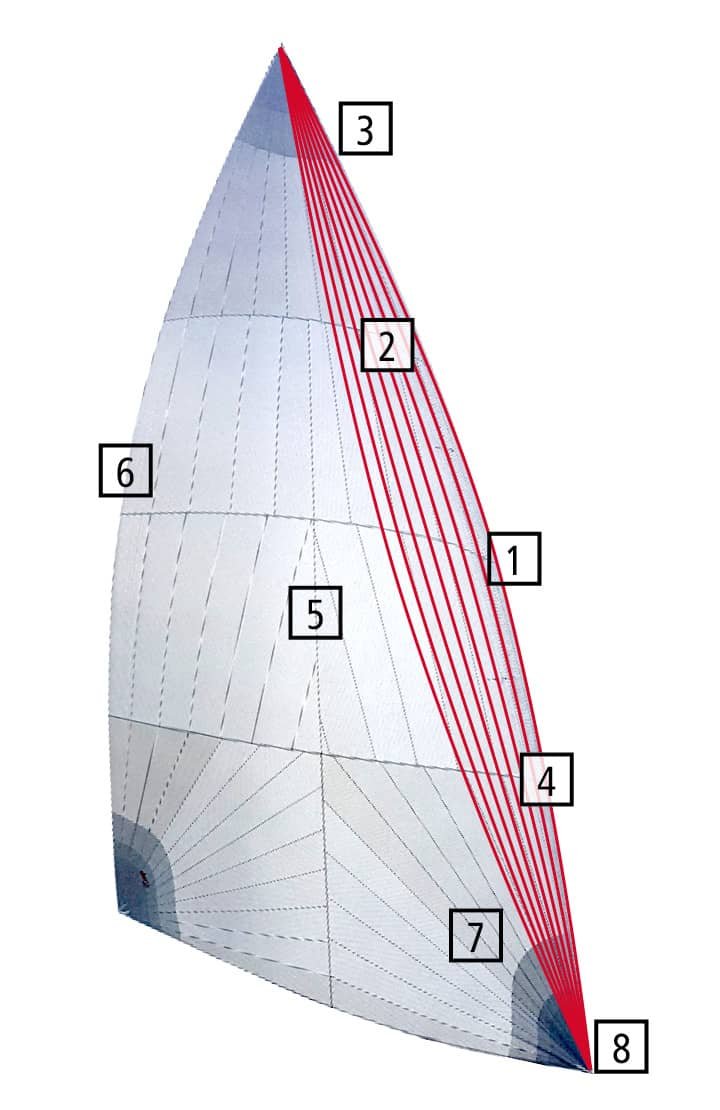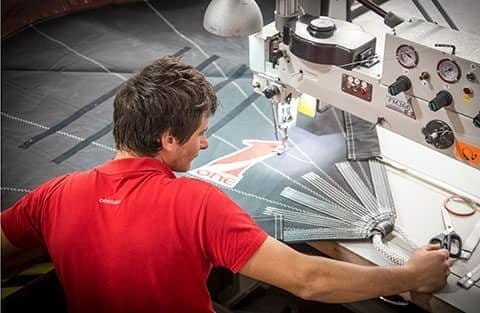Det sejl, der gennemgår den mest markante udvikling i dag, er spilersejlet.
Ved hjælp af bedre stoffer og sejlteknologi er spiler nu både langt mere effektive i medvind og så tætvindede ved 45° tilsyneladende vind.
Gennem erfaring med næsten identiske både er nøglen til offwind-hastighed blevet bestemt af spinnakerens form lige så meget som af spinnakerens størrelse.
Dette er især tilfældet på ethvert punkt, hvor man sejler højt i et dødt løb.
OneSails laver et bredt udvalg af højtydende spinnakere til kapsejladsbåde.
Designet af hver spinnaker er tilpasset båden for at give virkelig overlegen ydeevne.
Programmet, der bruges til at bestemme formen, tager også højde for forskydning for at sikre, at formen matcher båden.
Hos OneSails vil vores designteam gerne tale med dig om at skræddersy spinnakere, så de passer til din båd.
Deres indgående erfaring med alt fra America’s Cup til små One Design-sejlbåde sikrer, at de har den viden, der skal til for at give dig de rigtige råd.
Vi forsøger her at gøre det lettere for dig at udnytte det fulde potentiale i dit/dine nye sejl.
Sejlvalgsguiden under “Faster Off the Wind” giver dig en oversigt over, hvornår du skal bruge hvilken spinnaker.













Code
Sejladsaktivitet
TWS Knob
TWA Grader
Matriale
Fra
Til
Fra
Til
A055/065/075
Racing
2
20
50
110
Membrane eller Laminat
AF0
Racing
6
25
55
120
Nylon med lamineret forlig
AF1
Racing
4
15
70
130
Nylon med lamineret forlig
AF2
Racing
10
22
115
165
Nylon med lamineret forlig
AF3
Racing
12
26
110
145
Nylon med lamineret forlig
Der er ikke noget mere spændende i offshore-sejlads end power reaching – det sejlpunkt, vi drømmer om, og som gør de andre ben i en hård kapsejlads smerten værd …
Høje hastigheder, spray og det indre sus, vi får, når vi ved, at en båd presses til det yderste, mens sømilene hurtigt fortæres.
En ulempe ved dette sejl er dog den krængning og ubalance, der kan opstå, når der enten er for meget kraft på sejlplanen fra mastens Code 0 (MH0) eller endda den fraktionerede Code 0 (FR0), hvilket resulterer i dyre og til tider brutale kursafvigelser for at holde fast i disse sejl.
Alligevel er det svært at give afkald på farten og kraften, selv med de ekstra sømil – mens man konstant genberegner VMG-afvejningerne mod en lavere kurs.
Ofte er den eneste måde at holde sig højt nok oppe til at holde kursen på at reducere kraften og krængningsmomentet ved at slukke for de store sejl og skifte til mindre forsejl.
Men så er der et betydeligt tab af kraft og fart, og der er brug for mere af storsejlet for at opretholde drivkraften.
At bruge mere storsejl betyder, at lastbalancen flyttes bagud, hvilket igen resulterer i et større pres på roret for at holde kursen.
Jo mere storsejl, der bruges, jo mere ror er der brug for, og jo større er rorvinklen, hvilket skaber modstand og hæmmer farten yderligere.
Resultatet er ofte et “tomrum” for den ellers veludstyrede offshore-racer, hvor sejlene simpelthen ikke er optimeret til at få den bedste fart i den ønskede vinkel.
Den seneste generation af havkapsejlere, der jagter banerekorder, ved dette og er designet med deres master langt agterude, hvilket skaber enorme forvinger, hvor der kan flyves flere kombinationer af forsejl og stagsejl, ofte monteret på rullebukke, så de er nemme at sætte ud.
Ikke alle af os har den luksus at omkonfigurere hele båden – masteposition, sejlplan og vedhæng – bare for at få plads til en større fortriangel og forblive konkurrencedygtige i andre sejladsformer.
Men vi kan finde fart ved at reducere krængningen og samtidig bevare kraften i sejlplanen.
OneSails har arbejdet hårdt på dette problem.
Paul Eldrid fra OneSails i Perth forbereder sig på den australske sommersæson og undersøger, hvordan man kan sætte strøm til en række hurtige konstruktioner lige fra en Bakewell-White 36 til en HH42, DK 46, Carkeek 47 og flere TP52’ere.
Alle nyder godt af nye forsejlsdesigns fra OneSails.
Når der er plads til at sejle effektivt, vil flere forsejl ikke kun give mere kraft til bedre at afbalancere et fuldt trimmet storsejl og reducere modstanden fra roret, det vil også stabilisere strømmen over hele sejlplanen.
“Heldigvis er der ingen begrænsninger i IRC og meget generøse forsejlstilladelser i ORCi, som giver mulighed for at udvikle disse sejl, så de passer til en vigtig niche for kapsejlere,” siger Eldrid.
“Vi har gjort flere opdagelser i denne proces, som vi tror virkelig vil give bådene ny energi i reaching-forhold.
I stedet for det traditionelle arrangement med at sætte et forsejl i stævnen og derefter forsøge at få plads til et genua-stagsejl et sted på fordækket, har Eldrid eksperimenteret med at sætte det større forsejl ud for enden af bovsprydet (kaldet J0), hvilket giver masser af plads til at sætte et andet forsejl bagved, f.eks. det nye fok-stagsejl med firkantet top (JS).
Mange af os er vant til banesejlads, hvor alle forsejl har sejlpinde … det er ikke nødvendigt med disse udhalersejl, da dybden er længere agterude, og sejlpinde ikke behøver at være lige, faktisk skal de dreje for at give optimalt flow.
Uden sejlpinde bliver rullesejl en stærk mulighed for flere både.
De optimale kombinationer af forsejl, reaching-spinnakere og et rebet eller fuldskødet storsejl er mange og varierede.
Med tanke på omkostningerne udvikler OneSails nu “turboladede løsninger med flere forsejl”, der stadig bruger MH0- og FR0-nicherne, men nu supplerer dem med nye sejl, herunder J0 og JS.
Indtil nu har OneSails bygget disse sejl i panelkonstruktion, mens de tester formene i fuld skala.
Men virksomhedens design- og R&D-teams er også i gang med en mere omfattende FSI-undersøgelse (Fluid Structure Interaction), der skal give data til at begynde at bruge de kontinuerlige 4T FORTE-kompositmembraner i ét stykke for at optimere styrke og vægt.
“Vi ser allerede en stor interesse for at bringe det sjove og spændende ved mere effektiv reaching tilbage på alle baner”, siger Eldrid.
“Det er en spændende ny udviklingsvej.

Det er nemt at opnå en stor forstavn på en nybygget båd – man flytter bare masten agterud og justerer vedhængene i overensstemmelse hermed.
På eksisterende både er det ikke så let, og derfor har OneSails udviklet nye forsejl, der er specielt designet til at blive fløjet så langt frem som muligt fra sprydet.
‘Hullet’ udfyldes derefter med andre sejltyper, der vælges i henhold til båden og dens kapsejladsprogram.
Bemærk i simuleringen, hvordan sejldesigneren har modstået fristelsen til at være grådig med området i det forreste forsejl og valgt et mere jævnt flow over alle tre sejl.


Spinnaker-stagsejl kan forbedre præstationerne betydeligt, også på de kystnære læns-baner. OneSails har i årevis udviklet disse sejl, som var til stede i OneSails’ sejlinventar for ORCi-vinderne.

Over de sidste 15 år har OneSails’ designteam udviklet eksklusive teknologier for at gøre et fuldstøbt kontinuerlig sejl til virkelighed for cruise- og racingbåde.
Funktioner som vægt, formkontrol og deformationmodstand betyder bedre ydeevne sammenlignet med traditionelle panelsejl.
Sejlene er designet og fremstillet efter de højeste standarder med omhyggeligt udvalgte komponenter for at sikre den højeste kvalitet og holdbarhed. 4T FORTE™ membraner fremstilles eksklusivt i Italien. Hele samlingsprocessen foregår på én unik fabrik, der sikrer, at alle krav og standarder overholdes.
De bedste sejl faconer er et resultatet af kontinuerlig analyse og erfaring. OneSails er i spidsen for sejlfremstillings industrien og investerer løbende i forskning og udvikling for at sikre, at de allerbedste sejl faconer er tilgængelige. Succesen med denne tilgang bekræftes af det store antal trofæer, som OneSails-kunder har vundet ved nationale, internationale og verdensmesterskaber.
En kerneaktivitet for hvert OneSails Loft er at levere førsteklasses service, support og assistance. Som en del af vores serviceforpligtelse har hvert OneSails Loft et team af eksperter til rådighed for at sikre, at vi kan leve op til vores serviceløfte. Ud over et voksende antal hovedlofter har OneSails Group et omfattende netværk af servicecentre, der er strategisk placeret langs hele verdens kystlinje.

Signup our newsletter to get updates, information, news, insight or promotions: